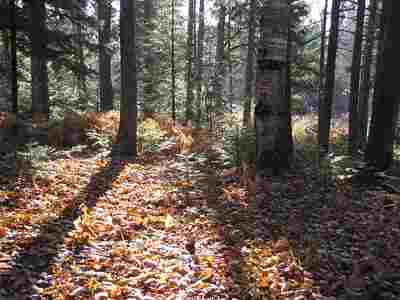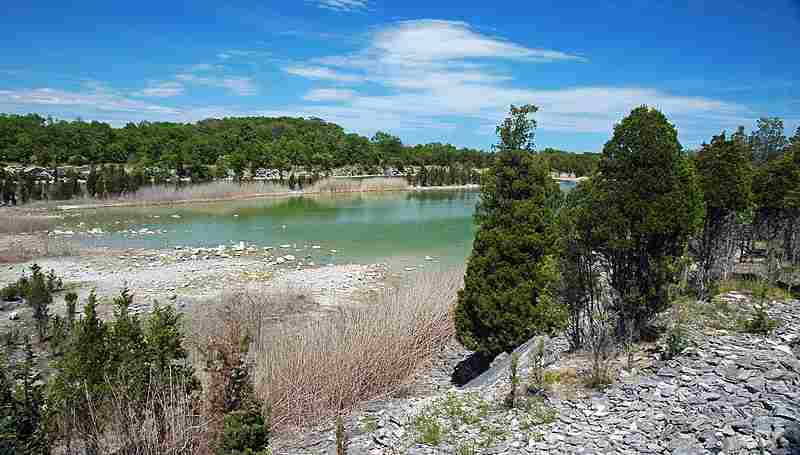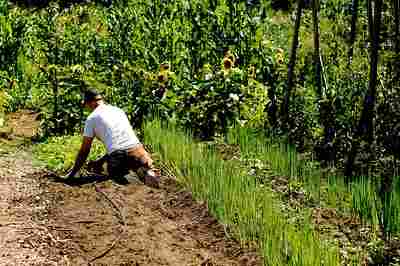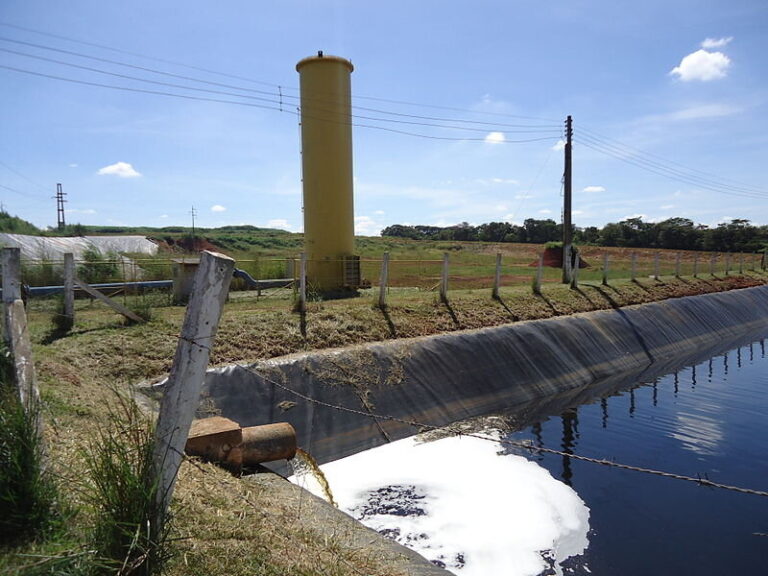Description of Forest Ecosystem Based On 7 Criteria
Description of forest ecosystem can be achieved using criteria like the dominant organic group, vegetative structure, biodiversity, soil conditions, climate, microhabitats, and nutrient dynamics of this biome.
This article discusses the description of forest ecosystem using various criteria, as follows;
1). Dominant Organic Group (as a criterion for the Description of Forest Ecosystem)
A forest ecosystem is primarily characterized and defined by its dominant organic group; which is trees.
Trees constitute the foundational element of the forest ecosystem, and significantly influence its structure, species richness, biodiversity, and functions.
Forests are unique and can be distinguished from other ecosystems as a result of their dense concentration of trees, and the various life forms which are associated with them.

As implied above, the dominant life form in a forest ecosystem is trees.
These towering woody plants are the most typical and definitive feature of forests, and provide resources like habitat and food, for a multitude of other organisms.
Trees function as primary producers in the forest food chain, by capturing and converting solar radiation through photosynthesis, to produce biomass [11].
Organic Components of Forest Ecosystem
In general, the organic components of forest ecosystems include; vascular and non-vascular plants, animals, microorganisms, and organic detritus.
Trees, which are the dominant life form, provide habitat, shade, and other forms of support for numerous organisms.
Asides trees, various other plants occur in forests. Several of these are part of the understory layer and forest floor vegetation.
A diverse assemblage of animals inhabit forests, including birds mammals, insects, reptiles and amphibians, which are adapted to specific niches or microhabitats.
Microorganisms in the forest ecosystem include fungi and bacteria, which are crucial for biodegradation, sustainable symbiosis, and recycling of ecologic resources like nutrients.
Detritus in forests comprises of fallen leaves, twigs, and other forms of plant and animal organic waste-matter that cover the forest floor, and provide nutrients for plants while sheltering some ground-dwelling organisms.
Soil organisms like detritivorous earthworms, also contribute to nutrient cycling and sustainability of the ecosystem.
Non-vascular plants like lichens and mosses are adapted to thrive in low-light conditions on the forest floor, and contribute to autotrophic diversity of the ecosystem.
Plants in forests produce a variety of fruits and seeds, which are important sources of food for primary consumers and omnivores.
The organic components of the forest ecosystem work collaboratively to create a complex web of trophic interactions, where each organism plays a specialized role in maintaining the delicate balance of life.
2). Vegetative Structure
The vegetative structure of forest ecosystems is another defining feature that contributes to their unique characteristics, and distinguishes them from other ecosystems.
Forests are characterized by a distinctive vertical arrangement of canopy layers, and a diverse assemblage of plants of varying morphological orientations [8].
This dynamic vegetative structure, plays a role in nutrient cycling, multispecies coexistence, and creation of microhabitats.
Structure of Vegetation in the Forest
In a forest ecosystem, the vegetation primarily comprises of trees, which coexist with other plants to form distinct canopy layers that include; emergent, understory, shrub and forest-floor layers respectively.
Canopy layer comprises the tallest trees, and may also be described as the emergent layer [5]. It forms the uppermost portion of the forest, and receives the most sunlight, which further increases its productivity and growth.
The understory layer consists of smaller trees and shrubs, alongside other plants that grow beneath the canopy. Plants in this layer are generally adapted to lower light levels.
Shrubs and understory plants constitute the shrub layer, which is found directly below the understory and contributes to overall vegetation density and diversity. Shrub layer is recognized as a distinct section of the vegetative structure only in forests where such plant assemblages are prominent.
The forest floor is the bottom layer of the forest vegetative structure, and is inhabited by plants that are tolerant of low light-intensity for their photosynthetic activities; such as mosses and ferns.
Importance of Vegetative Structure of Forests
The structure of a forest can be described by the spatial arrangement of canopy layers, and the morphological diversity of plants that contribute to each layer.
Forests can vary greatly in their structure on the basis of factors like soil type, degree of disturbance, and climate.
Mature and undisturbed forests tend to possess a more complex and intricate structure, with well-defined canopy layers and a well-developed understory.
On the other hand, forests that have experienced significant disturbance and degradation, might have a simplified structure with fewer canopy layers, lower morphological diversity; and a dominance of younger, smaller trees.
The importance of vegetative structure in forest ecosystem, includes its contribution to habitat-creation, nutrient cycling, light availability, organic adaptation, competition, and miroclimatic conditions.
Different canopy layers and understory, provide habitats for a broad range of plants, animals, and microorganisms, thereby contributing to regional biodiversity.
Nutrient cycling efficiency is also helped by the vertical arrangement of forest vegetation, which allows for efficient translocation of resources, with fallen leaves contributing immensely to soil fertility [9].
Both canopy layers and their arboreal inhabitants, compete for sunlight and other resources, in such a manner that drives adaptations in organisms and enables them to occupy specific niches in the ecosystem.
Lastly, the different vegetative layers create microclimates within the forest environment, influencing conditions like temperature and humidity.
Overview of Forest Vegetative Structure as a Descriptive Criterion
The vegetation in a forest comprises of multiple canopy layers including the emergent canopy layer, understory layer, and shrub layer.
In addition, the forest floor is usually covered with plants like mosses and ferns, which are adapted to low light conditions.
The structure of forests refers to the configuration of the different vegetative layers and life forms. Mature forests generally have a complex structure with well-defined layers, while immature, disturbed or degraded forests may have a simplified structure that is dominated by younger, smaller trees.
3). Biodiversity (as a criterion for the Description of Forest Ecosystem)
Biodiversity is an attribute that can be used in the description of the forest ecosystem, comprising of the abundance and speciation of its biotic factors, and setting it apart from other terrestrial ecosystems like tundras and deserts.
Forests are inhabited by a remarkable diversity of life forms, which contribute to their uniqueness, complexity and ecological relevance.
Overview of Biodiversity in Forest Ecosystems
Forest biodiversity is simply the variety of life forms found that occur within forested areas, including plants, animals and microbes, and the genetic differences between these organic groups.
It encompasses all species that are present in the forest, not solely the tree species.
Forest ecosystems are known for their rich biodiversity, as they are highly resourceful and support a vast array of organisms that contribute to their resilience and sustainability.
Significance of Biodiversity in Forests
The significance of biodiversity in forests stems from its contribution to the complexity, resilience, ecological relevance and stability of these ecosystems.
Forests play host to a vast number of plant and animal species, which make them some of the most biodiverse terrestrial ecosystems on Earth [10]. This is obvious in the case of tropical rainforests, which exhibit extremely high levels of biodiversity compared to other biomes.

Biodiversity in forests is a reflection of diversity at various levels, including genetic diversity within species. This type of diversity is crucial for adaptation, resilience and continuous evolution of species, especially in the face of modern environmental issues like climate change and extensive urbanization.
Various ecosystem-services that are provided by forests can be attributed to their biodiversity, including water purification, nutrient cycling, air quality maintenance, and pollination [1].
Higher biodiversity often contributes to ecosystem resilience and stability against disturbances, and helps forest ecosystems to recover after disruptions.
Distinguishing Forest Ecosystems Based On Biodiversity
The biodiversity of a forest refers to the vast genetic disparity among life forms present within the forested area, including plants, animals, and microbes.
Biodiversity is a key factor that can be used to distinguish forests from other terrestrial ecosystems. While these other ecosystems may also have significant levels of biodiversity, forests stand out due to their exceptional complexity and richness of species. Tropical rainforests, for example, are renowned for hosting an astonishing diversity of species that interact in various ways to form a resilient forest-food web.
4). Soil Conditions
Soil conditions are a defining abiotic factor in the forest ecosystem, which sets it apart from other ecosystems.
Forest soils possess unique physicochemical attributes that influence the cycling of nutrients, growth of trees, and the overall ecosystem health.
It must be noted that while a general assessment is used in this article, soil characteristics differ significantly from one type of forest to another; so that tropical rainforests tend to have relatively-low soil fertility while temperate forest soils are generally fertile.
Soil Conditions in Forest Ecosystems
Forest soils are characterized by distinct features like the presence of organic litter, soil-dwelling organisms, nutrient-cycling processes, and recognizable texture/structure.
Forest soils usually possess significant "litter layers", also called O horizons, that comprise of decomposing organic matter, including plant debris like fallen branches and leaves [4].
This layer contributes to soil structure, composition, and nutrient cycling.
Organic matter is therefore a major component of forest soils, mainly due to the accumulation of plant residue. This organic matter contributes to water-holding capacity, microbial dynamics, and fertility of the soil.

Trees in forested areas, recycle nutrients through their uptake, leaf fall and decomposition, by which they enrich the soil with essential elements.
Various soil-dwelling organisms also inhabit forest soils, including earthworms, insects and microorganisms, which are fully involved in decomposition and nutrient cycling processes.
The structure and texture of forest soils vary from one forest-type and geographical location to another. They are influenced by factors like climate, topography, parent material, and vegetation. These factors also collectively influence soil aeration, drainage, and water retention.
Significance of Soil Conditions in Forests
The significance of soil conditions in forests includes their influences on plant growth, nutrient-cycling, water retention, and microbial populations.
Tree growth and the overall health of forest plants, are determined significantly by soil conditions.
The availability of air, nutrients, and water, influences the development of root systems and the vitality of vegetation.
Cycling of nutrients is facilitated by forest soils, through processes such as the decomposition of organic matter. This process helps to release and replenish essential nutrients in the soil.
As stated earlier, the amount and type of organic matter present in forest soils, affect their water-holding capacity, and suitable organic composition can ensure effective water conservation, and steady water supply for plants, especially during dry periods.
Soil-dwelling organisms, such as bacteria and fungi, contribute to the breakdown of organic matter and transformation of nutrients, which affect soil fertility and ecosystem productivity.
Distinguishing Forest Ecosystems Based on Soil Conditions
Soil conditions can be used a distinguishing factor for forest ecosystems.
While other ecosystems also have soils with distinctive characteristics, forest soils are unique for their deep organic layers, vast microbial communities and intricate nutrient-recycling mechanisms.
These attributes are closely linked to the presence of trees, and the specific trophic composition/interactions within forest ecosystems.
The soil texture in a forest can vary on the basis of factors like climate, vegetation, microbes, erosion/weathering rates, and parent material. Forest soils may range from coarse to silty, impacting factors like drainage and water retention.
Physical characteristics of forest soil include texture, porosity, clastic structure, aeration, density, temperature, erosive mobility, and water retention. These attributes collectively affect the overall functionality of the ecosystem.
5). Climate (as a criterion for the Description of Forest Ecosystem)
Climate is another fundamental factor that distinguishes forest ecosystems from others.
Forests exhibit specific and measurable climatic characteristics that contribute to their other attributes like biodiversity and vegetation structure.
Climate Characteristics of Forest Ecosystems
The climatic characteristics of forest ecosystems are analyzed in terms of temperature, precipitation, and annual seasons, among other elements.
A range of temperature conditions occur in forest ecosystems, depending on their location.
Tropical forests are characterized by warm temperatures year-round, while temperate forests are subject to distinct seasonal changes, including cold winters and warm summers [6].

Forests generally receive ample precipitation each year, which sustains their lush vegetation.
Tropical rainforests are characterized by consistent rainfall, while other forest biomes may experience dry and cold seasons.
As earlier stated, distinct seasons occur in temperate forest biomes.
There are four of these seasons that define the temperate forest climate, including spring, summer, fall, and winter. These seasons are resultant of the Earth's axial tilt and solar incidence trends, and significantly affect both plant growth and animal behavior.
Tropical forests have a cooling effect on their local climate. They release moisture through the process of transpiration, which cools the surrounding air and produces rainfall, thereby exerting influence on regional weather patterns.
Growing seasons also reflect the climatic conditions in forest ecosystems, as they are determined by factors like temperature, humidity and precipitation. Temperate forests, for instance, typically experience a growing season of 140-200 days, which coincide with 4-6 frost-free months [2].
Significance of Climate in Forest Ecosystems
The significance of climate in forest ecosystems is a function of its involvement in the determination of biodiversity, vegetation types, and ecological processes, among others.
Biodiversity is influenced by the climate of a forest, through its direct determination of the types of species that can thrive within a given region.
Different climatic conditions foster the growth and biological success of different plant and animal organisms, that are adapted to specific ranges of temperature and moisture.
Types of vegetation that can thrive in a forest, are determined by climate. Tropical forests, for example, are inhabited by a dense canopy of evergreen trees due to their consistent humidity and warmth, while deciduous trees are adapted to the climatic conditions of temperate forests.
Important ecosystem processes are also influenced by climate, including nutrient cycling, decomposition and photosynthesis. These processes, in turn, affect the availability of resources for plants and animals.
Distinguishing Forest Ecosystems Based On Climate
The climate of forests, characterized by geographic temperature variations, distinctive precipitation patterns, and annual seasons, differentiates them from other ecosystems.
Characteristics of the forest climate include relatively-high precipitation, humidity and temperature, which often define distinct seasons.
The specific climatic attributes vary with the type of forest biome, as observed with tropical rainforests having warm temperatures and consistent rainfall; and temperate forests having distinct four-season cycles.
6). Microhabitats
Microhabitats within a forest, are specialized ecological niches that are characterized by unique environmental conditions, and influence both the behavior and distribution of various organisms.
These microhabitats are important for the maintenance of biodiversity, sustenance of specific life forms, and the overall productivity of the forest ecosystem.
Microhabitats in Forest Ecosystems
Microhabitats in forest ecosystems include; decomposing logs, tree cavities, bark, leaf litter, soil sedimentary pores, and vegetative canopy.
Decomposing logs on the forest floor, usually create microhabitats that are rich in saproxylic insects and microorganisms like fungi [7]. These decaying logs provide suitable shelter, as well as breeding grounds and food, for a variety of organisms. On a broader scale, they may contribute to regeneration and to nutrient cycling.
Tree cavities are formed by animal activity, growth deformation, and decay.
They may serve as microhabitats for some mammals, birds, insects, reptiles, amphibians and microbes. These cavities offer nesting sites and shelter to species that require precinct, secluded environments, and aid in the survival and reproduction of such organisms.

Tree bark is yet another forest microhabitat that supports a diverse community of organisms, including arachnids and epiphytic plants like mosses. These microhabitats provide refuge and essential resources for their inhabitants.
Leaf litter and soil sediments on the forest floor, serve as microhabitats for some organisms, which range from small macrobial invertebrates to microbes like fungi and bacteria. Inhabitants of soil microhabitats are generally vital in nutrient cycling processes.
The forest canopy itself is a unique and reliable microhabitat for species that are adapted to arboreal living conditions. Canopy-dwelling organisms include insects, epiphytes, birds, and some mammals like primates.
Significance of Microhabitats in Forest Ecosystems
The significance of microhabitats in forest ecosystems is based on their contributions to biodiversity, shelter-provision, and ecosystem health.
Biodiversity of forest ecosystems is supported by the presence of diverse microhabitats.
These ecological niches provide specialized conditions for a wide range of organisms, and sustain many species that might not thrive in the general forest environment.
Shelter, feeding opportunities and breeding sites are all provided by microhabitats, for various mammals, insects, plants and microbes. Microhabitats enhance the chances of survival and rates of reproduction, of species.
Ecosystem health benefits from microhabitats which facilitate decomposition and nutrient cycling, among other critical ecological processes. They also support forest regeneration by serving as reservoirs with nutrients and favorable conditions for organic resurgence.
Distinguishing Forest Ecosystems Using Microhabitats
Microhabitats in forests contribute significantly to regional biodiversity. This is because they provide distinct niches that support various organisms, and enrich the overall organic diversity of the forest ecosystem.
Microhabitats distinguish forests from other ecosystems by their number, magnitude, inherent conditions, complexity, and collective functions, which differ from those of other biomes on Earth.
The various kinds of microhabitats, such as decomposing logs, tree cavities, and canopy niches, along with their unique species assemblages, make up the organic structure of forests.
7). Nutrient Dynamics (as a criterion for the Description of Forest Ecosystem)
Nutrient dynamics in a forest ecosystem refer to the interconnected processes of nutrient acquisition, cycling, and redistribution that occur continuously within the ecosystem.
The availability and cycling of nutrients are both vital for the growth, development, and sustenance of the diverse/abundant organisms present in the forest.
Forests can be described and distinguished by their unique nutrient dynamics, that set them apart from other ecosystems, and play a key role in their functionality.
Nutrient Dynamics in Forest Ecosystems
The overall nutrient dynamics that can be used for the description of forest ecosystems, may be summarized into three stages including; acquisition, cycling and redistribution of nutrients.
There are multiple sources from which forests acquire nutrients, including soil, organic matter, and atmospheric deposition.
Trees and other forest plants, uptake essential elements like nitrogen, potassium and phosphorus, from the soil to support their development [13].
Cycling of nutrients is a continuous process within the forest ecosystem, that relies on various processes such as decomposition, nutrient uptake by autotrophs, and nutrient release through biodegradation.
Decomposers, like bacteria, fungi, and detritivorous annelids as well as arthropods, break down organic matter, and release nutrients back into the soil.
Nutrient redistribution within the forest ecosystem occurs through processes like nutrient leaching, nycorrhizal association, and root uptake. Mycorrhizal fungi are known to form symbiotic relationships with tree roots, which enhance the efficiency of nutrient uptake [3].
Fallen leaves, and animal-derived organic matter, contribute to the organic litter on the forest floor. Decomposition of such litter by microscopic decomposers, and detritivores, releases their inherent nutrients into the soil, thereby making these resources available for plant uptake.
Significance of Nutrient Dynamics in Forest Ecosystems
Ecosystem productivity depends on nutrient dynamics to remain optimal, within the forest ecosystem.
Nutrient availability directly influences photosynthesis and the growth of forest plants, which are the main components of primary productivity.
Biodiversity is also influenced by nutrient availability, which affects the composition and diversity of plant species in the forest.
Different species of plants have varying nutrient requirements [12], which can lead to niche differentiation and promote biodiversity.
Lastly, efficient nutrient cycling ensures that losses from the ecosystem are minimized, and the risk of resource depletion remains low. This in turn contributes to ecosystem resilience and long-term nutrient sustainability.
Distinguishing Forest Ecosystems Based On Nutrient Dynamics: An Overview
Nutrient dynamics in forests distinguish them from other ecosystems, owing to the unique interactions that occur among trees, soil, and decomposers.
Forests are characterized by intricate nutrient cycling systems that support their diverse fauna and flora, and set them apart from ecosystems with different nutrient dynamics.
The nutrient dynamics in the forest involve processes of nutrient acquisition, cycling, and redistribution. Nutrients are acquired from soil and organic matter, cycled through multiple biotic and abiotic interactions, and redistributed within the ecosystem.
Types of nutrient cycle in forest ecosystems include the carbon cycle, nitrogen cycle, sulfur cycle, and phosphorus cycle. These cycles are defined by the movement of nutrients through different components and segments of the ecosystem.
Most nutrients in the forest are found in the soil and its organic matter. Organic matter, like fallen leaves, contributes to the accessible nutrient pool on the forest floor.
Nutrients are also stored in animal biomass, which can be recycled through decomposition processes.
Conclusion
The description of forest ecosystem can be carried out based on criteria like;
1. Dominant Organic Group
2. Vegetative Structure
3. Biodiversity
4. Soil Conditions
5. Climate
6. Microhabitats
7. Nutrient Dynamics
References
1). Ahammad, R.; Stacey, N. E.; Sunderland, T. (2019). "Use and perceived importance of forest ecosystem services in rural livelihoods of Chittagong Hill Tracts, Bangladesh." Ecosystem Services 35:87-98. Available at: https://doi.org/10.1016/j.ecoser.2018.11.009. (Accessed 14 August 2023).
2). Azhar, M. F.; Bhabha; I. Q.; Shehzad, M. M.; Jamil, A. (2022). "Changing Climate Impacts on Forest Resources." Building Climate Resilience in Agriculture (pp.111-130). Available at: https://doi.org/10.1007/978-3-030-79408-8_8. (Accessed 14 August 2023).
3). Chen, W.; Koide, R. T.; Adams, T. S.; Deforest, J.; Cheng, L.; Eissenstat, D. M. (2016). "Root morphology and mycorrhizal symbioses together shape nutrient foraging strategies of temperate trees." Proceedings of the National Academy of Sciences 113(31). Available at: https://doi.org/10.1073/pnas.1601006113. (Accessed 14 August 2023).
4). Enchilik, P.; Aseyeva, E. N.; Semenkov, I. (2023). "Labile and Stable Fractions of Organic Carbon in a Soil Catena (the Central Forest Nature Reserve, Russia)." Forests 14(7):1367. Available at: https://doi.org/10.3390/f14071367. (Accessed 14 August 2023).
5). King, D. A.; Clark, D. A. (2011). "Allometry of emergent tree species from saplings to above-canopy adults in a Costa Rican rain forest." Journal of Tropical Ecology 27(06):573 - 579. Available at: https://doi.org/10.1017/S0266467411000319. (Accessed 13 August 2023).
6). Loidi, J.; Marcenò, C. (2022). "The Temperate Deciduous Forests of the Northern Hemisphere. A review." Mediterranean Botany 43:e75527. Available at: https://doi.org/10.5209/mbot.75527. (Accessed 14 August 2023).
7). Lonsdale, D.; Pautasso, M.; Holdenrieder, O. (2008). "Wood-decaying fungi in the forest: Conservation needs and management options." European Journal of Forest Research 127(1). Available at: https://doi.org/10.1007/s10342-007-0182-6. (Accessed 14 August 2023).
8). Mensah, S.; Du Toit, B.; Seifert, T. (2018). "Diversity-biomass relationship across forest layers: implications for niche complementarity and selection effects." Springer, Oecologia 187(1). Available at: https://doi.org/10.1007/s00442-018-4144-0. (Accessed 13 August 2023).
9) Owusu-Sekyere, E.; Cobbina, J.; Wakatsuki, T. (2009). "Nutrient Cycling in Primary, Secondary Forests and Cocoa Plantation in the Ashanti Region, Ghana." West African Journal of Applied Ecology 9(1). Available at: https://doi.org/10.4314/wajae.v9i1.45680. (Accessed 14 August 2023).
10). Pillay, R.; Venter, M.; Aragón-Osejo, J.; del Pliego, P. G.; Hansen, A.; Watson, J. E. M.; Venter, O. (2021). "Tropical forests are home to over half of the world’s vertebrate species." Frontiers in Ecology and the Environment 20(1). Available at: https://doi.org/10.1002/fee.2420. (Accessed 14 August 2023).
11). Pinkard, E. A.; Battaglia, M.; Roxburgh, S.; O'Grady, A. P. (2011). "Estimating forest net primary production under changing climate: Adding pests into the equation." Tree Physiology 31(7):686-99. Available at: https://doi.org/10.1093/treephys/tpr054. (Accessed 13 August 2023).
12). Sahrawat, K. L. (2006). "Plant nutrients: sufficiency and requirements." Encyclopedia of Soil Science Second Edition (pp.1306-1310.). Available at: https://www.researchgate.net/publication/267316294_Plant_nutrients_sufficiency_and_requirements. (Accessed 14 August 2023).
13). Santiago, L. S.; Wright, S. J.; Harms, K. E.; Yavitt, J. B.; Korine, C.; Garcia, M.; Turner, B. L. (2012). "Tropical tree seedling growth responses to nitrogen, phosphorus and potassium addition." Journal of Ecology 100(2):309 - 316. Available at: https://doi.org/10.1111/j.1365-2745.2011.01904.x. (Accessed 14 August 2023).














